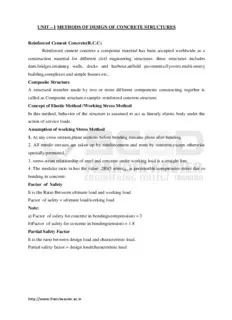
I METHODS OF DESIGN OF CONCRETE STRUCTURES Reinforced Cement Concrete(RCC) PDF
Preview I METHODS OF DESIGN OF CONCRETE STRUCTURES Reinforced Cement Concrete(RCC)
UNIT – I METHODS OF DESIGN OF CONCRETE STRUCTURES Reinforced Cement Concrete(R.C.C) Reinforced cement concrete a composite material has been accepted worldwide as a construction material for different civil engineering structures. these structures includes dam,bridges,retaining walls, docks and harbour,airfield pavements,flyovers,multi-storey building,complexes and simple houses etc., Composite Structure A structural member made by two or more different components constructing together is called as Composite structure.example: reinforced concrete structure. Concept of Elastic Method /Working Stress Method In this method, behavior of the structure is assumed to act as linearly elastic body under the action of service loads. Assumption of working Stress Method 1. At any cross section,plane sections before bending remains plane after bending. 2. All tensile stresses are taken up by reinforcement and none by concrete,except otherwise specially permitted. 3. stress-strain relationship of steel and concrete under working load is a straight line. 4. The modular ratio m has the value 280/3 stress is permissible compressive stress due to cbc bending in concrete. Factor of Safety It is the Ratio Between ultimate load and working load Factor of safety = ultimate load/working load Note: a) Factor of safety for concrete in bending(compression) = 3 b)Factor of safety for concrete in bending(tension) = 1.8 Partial Safety Factor It is the ratio between design load and characteristic load. Partial safety factor = design load/characteristic load http://www.francisxavier.ac.in Grade of Concrete and Apporximate Proportions Of Ingredients: GRADE OF CONCRETE APPORXIMATE PROPORTIONS OF INGREDIENTS M5 1:5:10 M7.5 1:4:8 M10 1:3:6 M15 1:2:4 M20 1:1.5:3 Factor Considered In Limit State of Collapse 1.Flexure 2.Compression 3.Shear 4.Torsion Factor Considered In Limit State of Serviceability 1.Defelction 2.Cracking 3.Durability 4.Viberation 5.Fatigue 6.Fire Resistance Factor Governing Concrete Mix Design: a)Grade of Concrete B)Type of Cement C)Cement Content D)Size.Shape,Grading Of Aggregate WORKING STRESS METHOD a) the stresses in an element is obtained from the working loads and compared with permissible stresses. b)the method follows linear stress-strain behaviour of both the materials. c) modular ratio can be used to determine allowable stresses, d) ultimate load carrying capacity cannot be predicted accurately. e) the main drawback of this method is uneconomical. http://www.francisxavier.ac.in LIMIT STATE METHOD a) The stresses are obtained from design loads and compared with design strength. b) in this method,it follows linear strain relationship but not linear stress relationship. c) the ultimate stresses of materials itself are used as allowable stresses. d) it shall also statisfy the serviceability requirements,such as limitations on deflection and cracking. VALUE OF PARTIAL SAFETY FACTOR FOR CONCRETE AND STEEL: a)partial safety factor for concrete = 1.5 b)partial safety factor for steel = 1.15 http://www.francisxavier.ac.in http://www.francisxavier.ac.in http://www.francisxavier.ac.in http://www.francisxavier.ac.in http://www.francisxavier.ac.in http://www.francisxavier.ac.in http://www.francisxavier.ac.in http://www.francisxavier.ac.in
